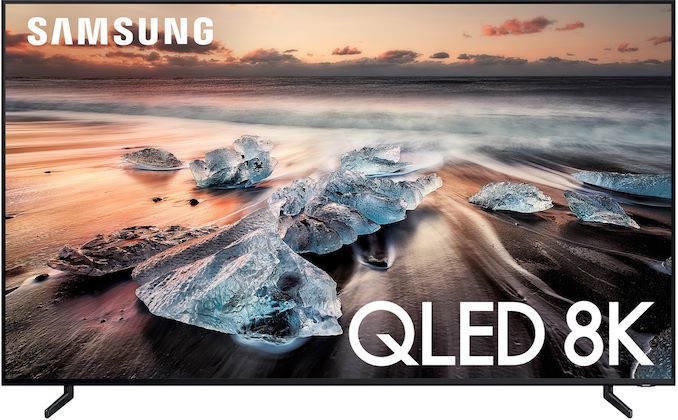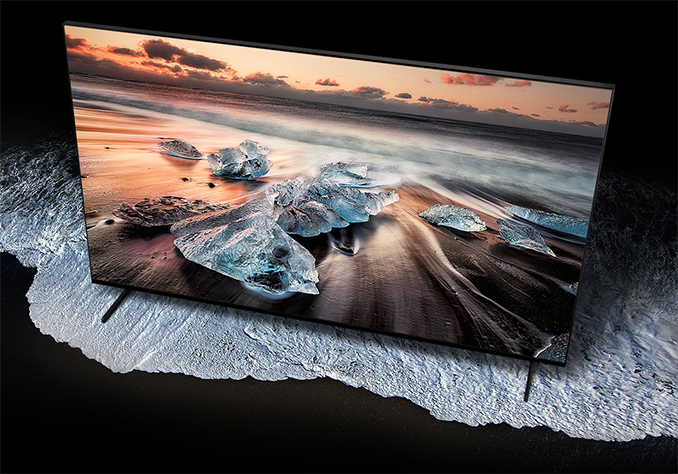Samsung’s 8K QLED TV 55-Inch: A More Affordable 8K Ultra-HD TV
by Anton Shilov on September 6, 2019 12:00 PM EST
Being flagship televisions available today, 8K Ultra-HD TVs not only feature a resolution of 7680×4320 pixels, but also pack all the latest technologies that manufacturers have to offer these days and therefore can provide ultimate experience even with 4K or 2K content. Samsung’s Q900 family of 8K TVs do exactly that, but because of its premium positioning, the company offered them in large sizes, which means price tags excessive for most. Up until this week.
At IFA, Samsung introduced its smallest 8K UHDTV to date: the Q900R 55-inch model QN55Q900RBFXZA, which costs significantly less than the rest of the SKUs in the lineup.
The television uses Samsung’s IPS-class 7680×4320 panel backed by a quantum dot-enhanced LED backlight that promises FALD-like operation, which Samsung dubs Direct Full Array 16X technology (in case of the 55-inch model). The TV features a peak brightness of 4000 nits, which is the maximum luminance at which HDR content is mastered these days. Speaking of HDR, the Q900-series officially supports HDR10, HDR10+, and HLG formats, but not Dolby Vision (at least for now). As far as color gamut is concerned, the Q900-series can reproduce 100% of the DCI-P3 space.
Just like its bigger brothers, the Samsung Q900R 55-inch uses the company’s Quantum Processor 8K as its brain. The SoC is responsible for all decoding, upscaling, and other operations. Among the capabilities of the chip that Samsung is particularly proud of is its proprietary 8K AI Upscaling technology, which is designed to enhance the quality of digital content to panel’s native resolution (does not work with PCs, games, analogue content, etc.). Furthermore, the SoC is also able to interpolate content to 240 FPS and supports AMD’s FreeSync/HDMI Variable Refresh Rate technologies.
Last but not least, the UHDTV comes with a 60-W 4.2-channel audio subsystem.
While technological excellence of Samsung’s Q900-series Ultra-HD televisions is well known, the key feature of the 55-inch model is its price. The 8K television carries a price tag of $2,499, which is in line with higher-end 4K TVs. Considering the fact that retail prices tend to fall below MSRPs, the 55-inch Q900 will likely be considerably more widespread than its larger counterparts.
Related Reading:
- 8K Association Sets Minimal Specs for 8K Ultra-HD TVs
- Sharp to Demonstrate 120-Inch 8K LCD TV & 8K TV with 5G Modem at IFA
- AU Optronics's New 85-Inch 8K LCD TV with 1,024-Zone Backlighting
- Samsung's 2019 QLED UHD TVs: 8K TVs Revamped, 4K TVs Get New Panel & Backlighting
- Samsung at CES 2019: 219-Inch and 75-Inch Micro LED Ultra-HD TVs Demonstrated
- Samsung Announces iTunes Movie & TV Show Support In Its 2018, 2019 Smart TVs
- Samsung Begins Sales of 65-Inch Q900R 8K UHDTV in the UK
- Samsung Starts to Take Pre-Orders on 85-Inch Q900 8K UHDTV
Source: Samsung











51 Comments
View All Comments
azazel1024 - Tuesday, September 10, 2019 - link
It's not. I wouldn't say it "drops off quickly". It is a linear progression and it happens to everyone. A texture is lower resolution needed than an individual pixel to see. It also depends highly on the contrast. The higher the contrast, the greater the distance you can decipher a pixel or texture.But it happens equally. The visual references used for "you can discern the difference between 1080p and 4k with this size television is X number of feet from the TV" applies to people with 20/20 vision and AVERAGE contrast.
Someone with above average visual acuity with a high contrast image will be able to tell the difference a lot further away.
However, with a 55" 8k TV, all else being equal, even someone with exception vision and a high contrast scene aren't going to be able to tell the difference at what one would normally consider reasonable distances. At that point you are talking being able to discern a difference at perhaps 3-4 feet away from the screen. Someone with average vision on a more average contrast image and it'll be significantly closer, maybe two feet away.
So rock on with finally seeing the texture of the weave on the actor's shirt that is filling 1/5th of the TV screen, by pausing it, getting up close and squinting. You won't be able to tell while sitting on your couch.
Also motion reduces visual acuity. Which also limits the gains in resolution. As it stands between 1080p and 4k, even at distances where you can discern the difference between them with average contrast between pixels, if those pixels are in motion you won't be able to tell the difference (even with lossless video compression).
So yes, it can be pretty confidently stated that pretty much nothing will be gained on a 55" TV going from 4k to 8k. You might gain something from higher contrast, more color depth, etc. The extra resolution itself, no, you pretty much won't ever notice a difference. As someone with 20/12 vision, I can say there isn't a chance in heck I'd notice it under any realistic viewing conditions.
Now 8k might be of some benefit to the really large displays, but you are still talking getting in to like 70+ inch displays and sitting real close to them to notice the difference. You might tell the difference then at maybe 5 or 6 feet away with certain scenes or high contrast pictures between 4k and 8k.
So if I was investing in an 85" TV, maybe 8k would be a sure thing (or not stupid). If my 65" 4k needs replacing, I sure won't be spending any time losing sleep over what resolution to get.
dullard - Tuesday, September 10, 2019 - link
You didn't actually attempt to understand my post. The thing is that with textures you CAN SEE THEM FROM YOUR COUCH, even with a small screen at 8K. That is the new thing that people need to realize.dullard - Tuesday, September 10, 2019 - link
Conventional thought was that you could not see fine details from far away. But, as soon as we actually had the TVs available and tested it, we found out that conventional thought was wrong. Yes, you can't see a specific pixel. But you can see a wide area of pixels from far away, even on a small screen, and the texture is visually different. Significantly different from 8K vs 4K when far away.BMNify - Tuesday, September 10, 2019 - link
OG, your mistaken, UHD2 8K was invented for exactly that purpose Public broadcasting of the TOKYO Olympics on Friday, 24 July 2020, 20:00(JPN) !! in 317 days 18hours5 8min 59sec,and beyond, aka IPTV, streaming end to end production to end consumer etc
i do know that BBC engineering with NHK, did engineer and test 50,59.94,100,150,200,250,300 Hz as the REQUIRED real UHD 8K 120FPS standard they layed out,along side the upto 22.2 engineering required AND TOLD EVERYONE over 6 years ago.
NHK also showcased a new 8K VR display during NAB 2018. The display was designed to eliminate the pixelated look common to current VR headsets….
as in,6 years ago their display partners did a prototype (i forget the exact size,recall) 3.5″/7″ 4k and 8k as a POC ,so if you take nhk papers above as a given, then human eye vr focal point times 1.5 the hight of a generic 3.5″/7” display at upto 300 Hz for VR gives you a target top spec.
------
Hybrid-Log Gamma (it created it jointly with the BBC).
NHK’s engineers
https://gizmodo.com/okay-this-argument-for-8k-tvs-...
Okay, This Argument for 8K TVs Is Kinda Convincing
Alex Cranz,1/15/19 10:12am
…And this is where things get complex. Here we turn to a 2013 paper describing a study by a group of NHK engineers. The NHK is Japan’s public broadcasting organization—think PBS or the UK’s BBC—and it is heavily involved in creating broadcast standards, encoder types, and even the very first HDR standard for broadcasting, Hybrid-Log Gamma (it created it jointly with the BBC).
NHK’s engineers posited that there is a distance where an object on a TV, under optimal lighting, will appear as real to the human eye as the actual object…
..Despite this commonly accepted wisdom, the NHK paper’s research suggests that the distance for a more “real” image on an 8K display isn’t .75 H but 1.5 H, the same as a 4K set for visual acuity. Which means if NHK is right, an 8K TV in the same space as a 4K TV should feel more “real” when sitting the same distance from the TV. (This ITU paper on the state of UHD TV has one of the easier to grasp explanations of “realness” in TV.)..
dullard - Friday, September 6, 2019 - link
This TV is only 160 PPI. Plenty of people can see far better than 160 pixels per inch. Just think of the thousands of uses for static images on a TV (art, advertising, maps, information screens, business meetings, displaying photos, etc). TVs aren't only for watching at a distance. Please try to think beyond your limited use case before posting.FreckledTrout - Friday, September 6, 2019 - link
You are right but have you calculated how close someone with 20/20 vision would need to be to see better than 160 PPI? When you do and realize you wouldn't be able to see the entire screen you are going to feel silly about this post.dullard - Friday, September 6, 2019 - link
Hmmm, how close are people to 8K TVs?https://www.digitalavmagazine.com/wp-content/uploa...
https://i1.wp.com/www.gadgetguy.com.au/wordpress/w...
http://www.digitalavmagazine.com/en/wp-content/upl...
I could go on and on of examples of where people are close to TVs and need detail.
dullard - Friday, September 6, 2019 - link
Here are a few more examples:
https://www.electronicwhiteboardswarehouse.com/pub...
https://ak5.picdn.net/shutterstock/videos/33368575...
https://asia.nikkei.com/Business/Biotechnology/8K-...
Am I supposed to feel silly?
Beaver M. - Friday, September 6, 2019 - link
With such examples... yes.dullard - Friday, September 6, 2019 - link
Which examples would you perfer? I can post thousands more examples where 8K is used up close.